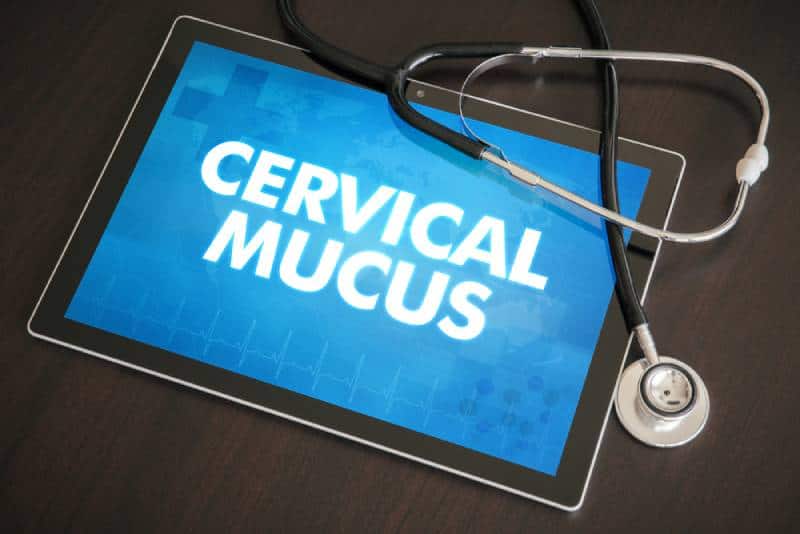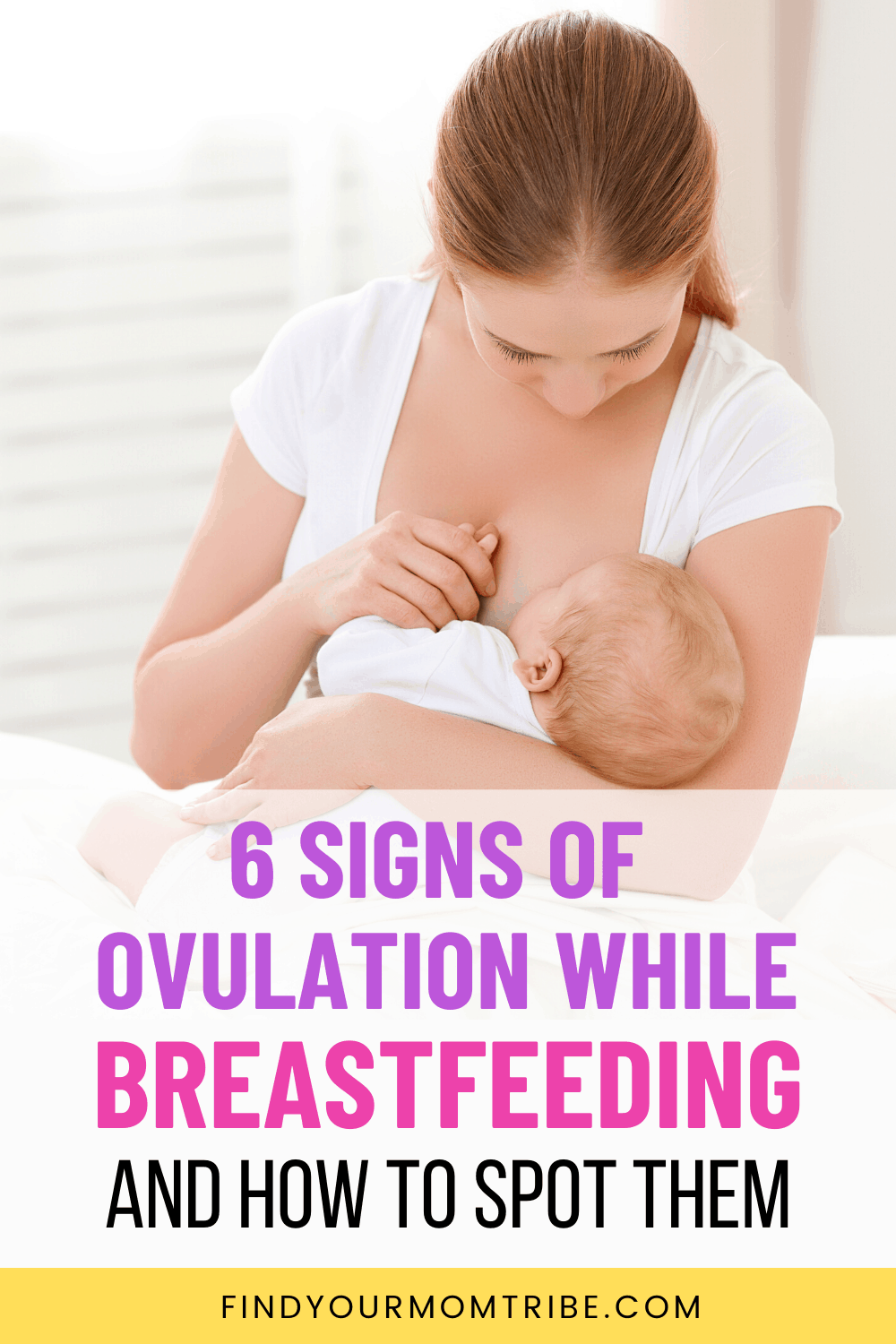While many mothers get excited at the prospect of getting another child into the mix, you might notice a lack of any signs of ovulation while breastfeeding for the first six months of pregnancy.
These signs of ovulation while breastfeeding show primarily due to a set of hormonal shifts that happen within your body.
They act as a form of birth control, suppressing your menstrual cycle if you stick to exclusively breastfeeding your newborn baby and not relying on any supplements like baby formulas or other foods/liquids.
The main culprit here is the prolactin hormone, responsible for said suppression, or rather, the suppression of gonadotropin and the follicle-stimulating hormone which are responsible for the whole process of ovulation.
And prolactin, as the name implies, is a hormone that will start being produced in much larger quantities during this initial 6 month period after delivery in order to stimulate milk production to satisfy your little one’s needs.

While a somewhat effective birth control method for breastfeeding mothers, it’s still not recommended to solely rely on it while having unprotected sex.
You may still end up conceiving well before the recommended period, which is 24 months postpartum.
Whether it’s through the use of an IUD, birth control pills, various fertility treatments, or any other form of birth control from your partner’s side, at least one of these is required to supplement this natural birth control method that comes with exclusive breastfeeding.
Why? Because the act of exclusive breastfeeding isn’t the easiest to maintain. A recent study showed that about 68% of women will quit half-way through the initial 6-month period.
This means that their prolactin levels have probably decreased somewhat and their ovulations may have returned, despite still breastfeeding their child.
How Does Breastfeeding Impact The Ovulation Process?

As mentioned earlier, prolactin is the key culprit in stifling the process of ovulation. Control it and you’ll be able to return to your fertile phases sooner rather than later.
Prolactin is created when there’s a need for breast milk production.
It’s the hormone that signals the brain that more is going to be needed to feed this little bundle of joy resting in your embrace, safely suckling on his daily nutrients.
This hormone is also responsible for the so-called maternal instinct that gives a mother this extraordinarily tight bond with her child and the need to keep him safe from any potential dangers.
This is what makes us mammas just that tiny bit more nervous and on-edge when people come around wanting to pick our baby up.
But, because of the need to focus on these functions as they take priority, the brain wants to take away from inciting the one thing it thinks we don’t need at the moment – to enter our fertile periods.
The brain knows how tender our body becomes for a period of time after our child is born and is trying to give us some time to rest for as long as we keep our kids on the breast.
That said, prolactin also needs a safety valve of its own – too much of it and you’d be having milk spills all day long on your favorite blouses.
There are the so-called pregnancy hormones, better known as estrogen and progesterone, which help safeguard the milk reserves all the way up until delivery when they take a rather significant drop to help us lactate to be able to provide for our child.
There is one other rather important hormone to thank though – one that plays a vital part both during pregnancy and the period after it, as well as throughout our lives in general.
It’s the feel-good, cuddle hormone called oxytocin.
Now, oxytocin is usually a hormone that triggers when we feel happy and content – when we’re hugging someone or we’re simply in love. That’s how it works for everyone.
Now, for women, oxytocin plays a few more roles, the first major one being during pregnancy where it helps contract the uterus so that we’re able to properly deliver the baby without any lasting consequences.
It’s also responsible for helping the uterus shrink down to a normal size over the first 6 weeks of postpartum.
But that’s not the hormone’s only purpose.
It’s also the middle man between prolactin and the brain where it sends the signal that more milk needs to be produced to satisfy your hungry little hugger.
That’s why you tend to feel this overwhelming dose of motherly love and affection toward your baby during your breastfeeding sessions.
Not only does it help you form a closer bond with them, but the closeness is reciprocated in full from the baby’s end as he starts generating oxytocin of his own, imprinting onto you (so to speak) and loving you unconditionally.
Signs Of Ovulation While Breastfeeding
So what are the signs that you’re beginning to ovulate again then?
Well, some might seem somewhat familiar and rather easy to spot when your fertility begins to surface, while others may be a bit less apparent.
1. Your menstruation has returned

Ovulation is a big part of the menstrual cycle, given how menstruation happens when an egg from the ovary is rejected, hence the bleeding.
Once you have your first period after delivery, it’s more than likely that you’re starting to ovulate again and that your fertility has started returning to you.
Now, if you’re planning to have another baby, it’s wise to use a menstrual calendar or an ovulation calculator.
Lucky for us, modern times provide us with a number of online tools other people have prepared for us so we don’t have to do it all by hand anymore.
So planning shouldn’t be that big of an issue.
That said, I urge you to not begin to try conceiving another child until at least two years have passed since you gave birth to your last one, for a number of health-related reasons.
The main ones are an increased chance of premature birth and failed pregnancies.
Be patient and good things will come to you.
2. A shift in the viscosity of your cervical mucus

Normally this isn’t something you’d pay too much mind to, but when you start ovulating again, you’ll notice that the cervical mucus that you normally excrete during a menstrual cycle starts off as a somewhat thick and sticky liquid.
It’s completely harmless for the sperm and tends to help house them in the fallopian tubes for a few days until the ovulation phase begins.
Once it does, the aforementioned cervical mucus is going to start turning a lot more liquid, less viscous, and easier to wade through for the sperm looking to fertilize the egg.
You’ll note the difference by seeing the mucus become a lot clearer and actually feel wet compared to the earlier mentioned state.
It’ll also have a texture somewhat akin to that of an egg-white.
This is one of the surefire signs of pregnancy being a possibility yet again (if you’re so eager to expand your family this quickly).
Do keep in mind that the ovulation phase doesn’t last forever and that it’s at this time that you have the highest chance of conception throughout the entirety of the menstrual cycle.
You’ll know when this period is over when the cervical mucus turns extremely thick, seeming like molasses at times more than anything else, and reducing in volume quite a bit.
It also turns nearly as white as the walls themselves.
This is usually a few days before menstruation to signify the end of the cycle.
3. Mild increases in body temperature right after an ovulation phase

It’s not uncommon for women to get a slight fever right after they’ve ovulated.
It’s not an overly large increase – it might hit 100°F if it goes high enough – but usually it’s nothing to worry about, just your body exerting itself a bit as it moves back into the cycle.
The importance of this sign is that it’s rather helpful in predicting your menstrual patterns so you can keep track of them with a lot more ease and precision.
You should use a quick and precise thermometer that doesn’t have a big margin of error, as well as note that the rise in temperature occurs about three days after the actual ovulation.
4. Cramping

While certainly nothing new for us mammas and something that might be hard to notice, given that you’ll be sitting down for most of the initial 6-month period anyway, cramping is another sign that your ovulation cycle might be returning to you.
Usually, you’ll feel it in your lower abdomen creeping up as a dull pain while the process develops, stopping once the egg is released from the ovary.
The stopping of that pain is a signal that your ovulation cycle is at its prime and should be noted as your most fertile period should you be looking to conceive.
This “fertile window,” as some would put it, is a period when the sperm travels up the fallopian tubes to fertilize the egg so it can move over to the uterus and slowly grow into a beautiful future child.
5. An increased libido

The one thing our hormones don’t do is leave us alone.
Love them or hate them, they do control most of our emotions and bodily functions, and while they can be amazing at times, they too have this note of irony to them.
Despite the two-year hazard period, our hormones decide to go wild when estrogen keeps getting pumped into us as well as the luteinizing hormone (LH) during the luteal phase.
It’s merely our body reacting to this internal instinct to reproduce, one that all living beings possess.
The only difference is that we’ve evolved past the need to do it every time we’re ready to bring a new life into the world, and we’ve realized that it’s a big responsibility to take care of a child, especially in the modern world with so many things bombarding us left and right.
But, you came here looking for signs of ovulation, not the opposite, and this is definitely one.
You may feel a bit heated and more responsive to outside sensors during this period, but I’m sure that’s not exactly a new experience for you.
6. Breast tenderness

And the last of the more important signs of ovulation while breastfeeding is mastalgia , better known as breast tenderness or cyclical breast pain.
It’s the residual pain from when the hormones start playing up and it will last for a few menstruation cycles once your fertility periods have returned.
Rest assured that it should fade with time. If it doesn’t, consult your doctor or lactation consultant to see what the issue might be.
Why Isn’t It Safe To Try Conceiving So Soon After A Birth?

I’ve said this in a few prior articles and I’ll always repeat it since it’s a matter of utmost importance.
There is a reason that gynecologists and other healthcare professionals say that you shouldn’t try conceiving another baby for at least two years after your initial delivery, especially if you had a C-section.
That’s because your body has just gone through a drastic bit of trauma and needs time to recover.
You were stretched out, nauseous, your hormones were exploding, you were eating all kinds of weird combinations, and you may have even gone through some illnesses, not to mention the pregnancy pains and the actual delivery.
While the product is beautiful, the way to it is filled with a lot of nasty stuff and it takes a toll on your body. Despite what people might say, it’s weakened.
Chances are that trying to conceive a baby too soon might not go as well as the first one did and may have disastrous results in the end.
Anything from increased odds of contracting preeclampsia to a number of complications during the delivery period, even leading to premature birth.
Not to mention the worst case scenarios where you, your baby, or both of you might not make it if you force yourself too hard.
Even the strongest of supermoms cannot withstand undertaking that ordeal so soon after the last one.
While yes, chances are good that both you and the second baby will come out of it unscathed and perfectly fine, chances are something that shouldn’t be toyed with, given that it’s not just your life that’s on the line here.
This may sound rude, but you have to think of others, mainly your first child and your partner. What are they going to do if they lose you?
A child needs a mother alongside them more than anything else in the world and nobody should have to grow up without both parents present.
Just be patient, don’t rush it. You’ve waited this long to start a family, what’s two more years for another addition?
Your kids will still get along just fine with each other despite the slight age difference, and it’ll be easier on your wallet because the second child can inherit the clothes of his older sibling.
It is your choice in the end and you raise your family the way you want, but I do implore you to heed my advice at least for this one bit so you can have the best chances of having a healthy and happy one, and not have to worry in the future.
Think of it as investing your time to get a lot less worry out of it for you and your entire family.
How Regulating What You Do Affects Your Fertility Period During Postpartum
Whether you want to conceive soon after birth or not, there are some tips and tricks on how to go about it to increase your chances.
Some might want to rush it (which is personally not recommended, but it’s up to you as mentioned before) while some want some extra time off from going through the sometimes annoying process of “that time of the month.”
Keeping yourself steady throughout the first 6 months
If you fall under the category of those who would rather not go through the same song and dance you’ve been going through since puberty for just a little while longer, then you might want to look into exclusive breastfeeding.
Exclusive breastfeeding

This is a lifestyle choice where you do nothing but feed your child breast milk straight from the source for the entire six-month period, give or take a few days depending on how fast your child advances.
While some women end up feeding their kids for longer (up to nearly two years), it’s not smart to keep them on the breast for too long to prevent any form of attachment issue.
Plus, your baby has to start taking in some solid foods sooner rather than later.
No supplements, pumps, or fake nipples

This means that during this 6-month period, you’ll have to ignore any sort of supplement that might replace a feeding session, risking the level of your oxytocin and prolactin hormones reducing in your system.
It also means that you cannot use pacifiers or baby bottles to feed your child for the exact same reason, or even a breast pump for that matter.
You need the natural sucking motion of your child to be applied to your breast so you can stimulate the hormone production.
It simply doesn’t add up to the same effect otherwise.
Breastfeeding 101

You’ll also need to be confident in knowing how to breastfeed your baby properly.
Don’t skip out on those maternity classes and look additional breastfeeding hacks and information up on the internet if need be.
The smartest thing to do would be to always keep in contact with your lactation consultant so she can help guide you through the process should you need to switch up your techniques.
Feed early and feed often

The more feedings you have, the more hormones you’ll end up producing, keeping both you and your little one sated – her in a manner of food, and you in a manner of pain relief and birth control.
Also, make sure to always be on call if she were ever to get hungry at a random time.
Do be careful though, excess feeding may lead to an oversupply of milk, which can lead to a whole different set of problems.
A warning: Use other methods of contraception as well

As good of a natural contraceptive as prolactin and oxytocin can be, it doesn’t mean they’re foolproof.
You can’t exactly know when your menstrual cycle has returned and with it the ovulation phase, since menstruation comes after the ovulation phase is over.
This means you might end up conceiving despite not wanting to if you want to enjoy intercourse during this period.
So stick to supplementing those chances of yours with added methods of contraception as well and don’t leave things to chance.
Make sure to look for any of the abovementioned signs of ovulation while breastfeeding as well as be fully prepared.
Wanting the return of ovulation
If you’re wanting to return to the old ways and improve your fertility for better chances at a future pregnancy, while still maintaining a steady flow of milk to your baby, don’t worry – I’ve got you covered too.
Keep the number of actual breastfeeds low

Going contrary to the suppression of the signs of ovulation while breastfeeding, you need to limit the amount of actual times you breastfeed the baby.
I don’t mean cut them off altogether, mommy and baby bonding time is still crucial in your little one’s growth cycle and he still needs the nutrients from the milk to grow.
You’ll still feed him a similar amount to what you’d do otherwise, you’d just swap over to using a breast pump to help store milk to feed it in a bottle later.
That way you’ll be able to lower the amount of prolactin and oxytocin produced and you’ll be able to get back to ovulating sooner.
It’s up to you on how you want to go about it, but I suggest a slower transition so your baby can adjust to it better.
Some sacrifices have to be made for the benefit of our kids, after all.
Don’t worry about it

As with any problem related to the body, stress plays a key role in any abnormalities.
Find the time to relax, try to get your mind off your fertility dilemmas, and just enjoy the time you have with your baby.
Focus on him and you’ll be back to your monthly menstrual cycle in no time.
What Does It All Mean?
It means that unlike with most other hormone-induced problems, this one you can actually influence through a few lifestyle choices, and both paths are correct.
All it takes is paying a bit of attention to the signs of ovulation while breastfeeding to know the right course of action to take.
It’s all just a matter of preference and heeding the warnings I gave throughout the article so you don’t slip-up after doing so well for a good period of time.
I wish you good luck on your family raising journey, mammas.
References:
- Miriam H. Labbok, MD, MPH, from Breastfeeding Abstracts, August 1993, Volume 13, Number 1, pp. 3-4. ”The Lactational Amenorrhea Method (LAM)”: Another Choice for Mothers”
- Campino C, Torres C, Rioseco A, Poblete A, Pugin E, Valdes V, Catalan S, Belmar C, Seron-Ferre M. “Plasma prolactin/oestradiol ratio at 38 weeks gestation predicts the duration of lactational amenorrhoea.” Hum Reprod. 2001 Dec;16(12):2540-5.
SEE ALSO: The Relation Between Breastfeeding And Period Cycles
Like this post? Please share or pin it for later. You can also stay in the loop and follow us on Facebook, Instagram or Pinterest.

This post contains affiliate links. Please see our full disclosure for more info.

